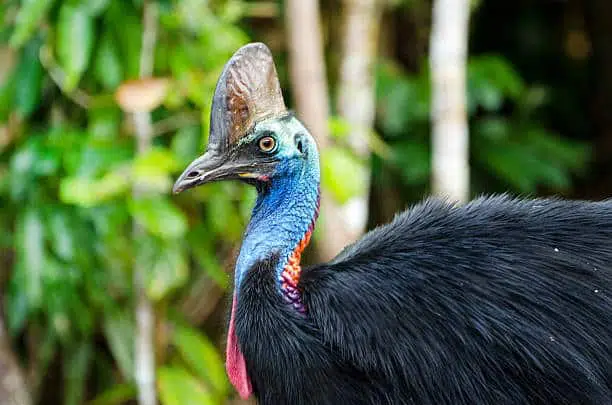Welcome to the Top 10 Most Aggressive Animals.
You might be surprised but the strongest creatures on the planet do not automatically make up the list of most aggressive animals. Temperament is what plays a vital role in defining aggression in animals.
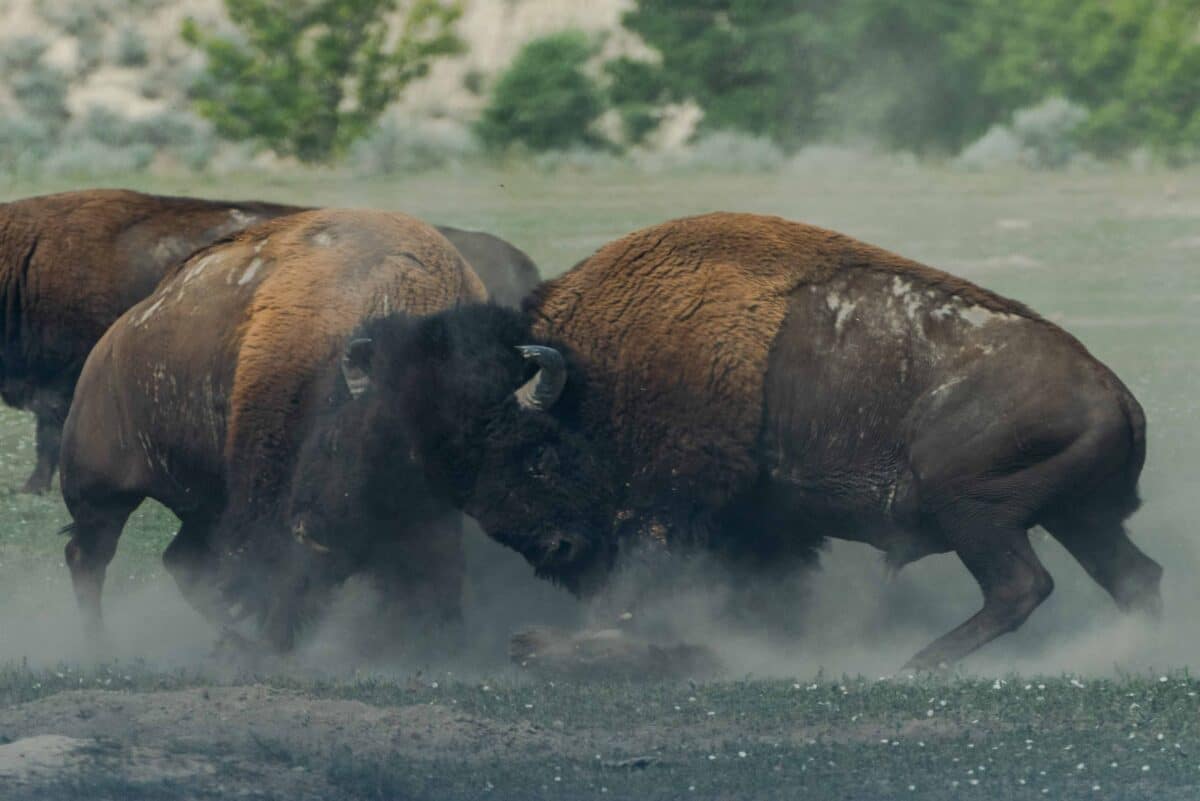
This list introduces you to the top 10 animals with hot tempers, known for their quick and fiery anger.
The reasons behind their aggression are diverse. It’s their unique way of communicating, asserting authority over their territory, or demonstrating dominance over other animals.
Click below to jump to a section on the top 10 most aggressive animals:
Key Points
| Rank | Animal | Description |
|---|---|---|
| 1 | Black Mamba | Highly venomous, fast ground snake |
| 2 | Cape Buffalo | Large and ferocious buffalo |
| 3 | Wild Boar | Omnivorous with destructive tusks |
| 4 | Hippopotamus | Massive size, dangerous behavior |
| 5 | Sun Bear | Small bear species, nocturnal, sharp teeth |
| 6 | Saltwater Crocodile | Enormous, powerful, excellent swimmer |
| 7 | Cassowary | Dangerous bird, fast runner |
| 8 | Moose | Giant deer with distinctive features |
| 9 | Wasps | Predatory insects with various species |
| 10 | Tasmanian Devil | Largest marsupial, aggressive behavior |
#1 Black Mamba
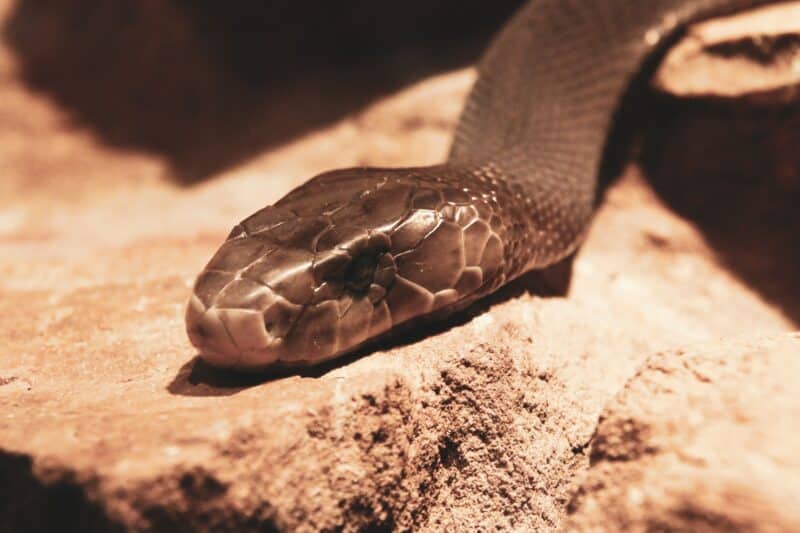
The Black Mambas, found in the sub-Saharan desert in Africa, are widely regarded as the most dangerous snakes on the planet. While still incredibly lethal it is not the Most Venomous Snake in the World, which is an entire different species. These snakes, however, are known for their lethal venom, are light brown with a darker color near their mouths. Just two drops of their venom can be deadly. Black Mambas can grow up to 1 foot in length and are known for their incredibly destructive toxins, including neurotoxins, cardiac poisons, and other potent substances. They are also considered the fastest ground snake on the planet, capable of reaching speeds of up to 20 kilometers per hour.
| Traits | Description |
|---|---|
| Habitat | Sub-Saharan desert in Africa |
| Venom | Highly dangerous, just two drops can be lethal |
| Size | Up to 1 foot in length |
| Speed | Fastest ground snake, up to 20 km/h |
| Color Variation | Light brown to dark brown, with light underparts |
| Species Variation | Two kinds, dark and green mambas |
Physical Characteristics and Behavior
Black Mambas typically range in color from light brown to dark brown, with light-colored underparts. There are two kinds of mambas, one dark and one green, distinguishable by their color. The dark mamba is found in rocky and soft wetland areas filled with herbs. They are known for their incredible speed, capable of crawling at 19 km per hour. These snakes primarily feed on small birds and some vertebrates. During the mating season, they lay around 6-20 eggs in one season. When agitated or threatened, they raise their necks in an S-shaped posture, open their mouths, and are known for their slow, calculated strikes. This behavior earns them a place on the list of the top 10 most aggressive animals.
| Traits | Description |
|---|---|
| Color Variation | Ranges from light to dark brown, with light underparts |
| Species Variation | Dark and green mambas |
| Habitat Preference | Dark mambas prefer rocky and soft wetland areas |
| Speed | Very fast, can crawl at 19 km/h |
| Diet | Primarily small birds and some vertebrates |
| Reproduction | Lay 6-20 eggs in one season |
| Aggressive Behavior | Defensive display with raised neck and open mouth |
Venom and Aggressiveness
The venom of Black Mambas is exceptionally toxic, and just two drops can be lethal to humans, often leading to cardiac arrest or respiratory failure. They are known for their fast-crawling capabilities and possess powerful venom.
| Traits | Description |
|---|---|
| Venom Toxicity | Exceptionally toxic, just two drops can be lethal |
| Aggressiveness | Defensive and can be very aggressive |
| Fast Crawling | High speed and powerful venom |
#2 Cape Buffalo
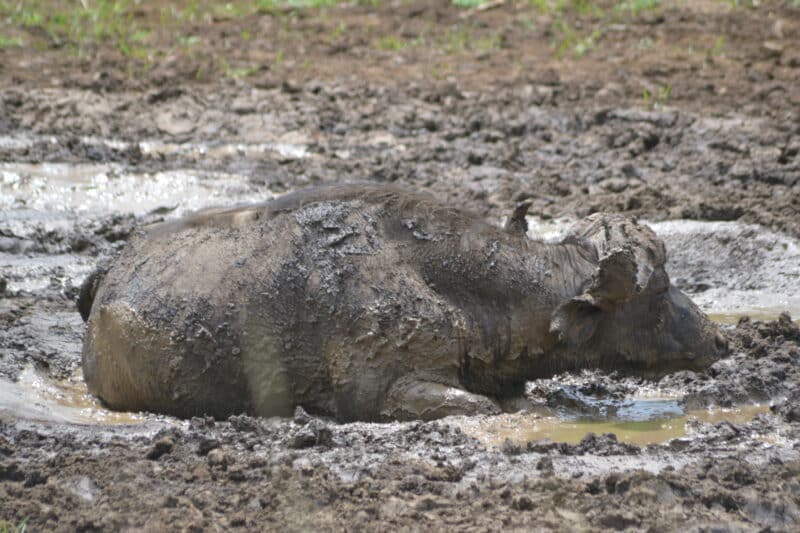
The Cape Buffalo, standing at 6 feet tall, is famously known as the “dead buffalo” due to its vigorous and energetic behavior. You can read all about their size in our article about the top 10 largest land animals! This species is known for being one of the most ferocious creatures on Earth, displaying offensive and protective procedures. It is also the dominant individual of the buffalo commonly found in Africa.
| Traits | Description |
|---|---|
| Size | 6 feet tall |
| Behavior | Energetic and vigorous, capable of running at 57 km/h |
| Diet | Primarily herbivores, primarily eat grass, require ample water |
| Ferocity | Among the most ferocious creatures on Earth |
| Social Structure | Often found in groups, with males, females, and offspring |
Physical Characteristics
Cape Buffaloes have a distinctive appearance with their thick coat of hair, which can range from black to earth-colored. They have large heads, powerful horns, giant bodies, and strong legs.
| Traits | Description |
|---|---|
| Coat Color | Thick hair, typically black or earth-colored |
| Head and Horns | Large heads, powerful horns |
| Body Structure | Giant bodies, strong legs |
Diet and Behavior
While they are primarily herbivores, Cape Buffaloes may resort to eating shrubs and trees when grass resources are scarce.
| Traits | Description |
|---|---|
| Diet | Mostly herbivores, occasional shrubs and trees |
| Group Behavior | Typically found in groups with males, females, and offspring |
Lifespan
The average lifespan of an African buffalo is around 20 years in the wild.
| Traits | Description |
|---|---|
| Lifespan | About 20 years in the wild |
#3 Wild Boar
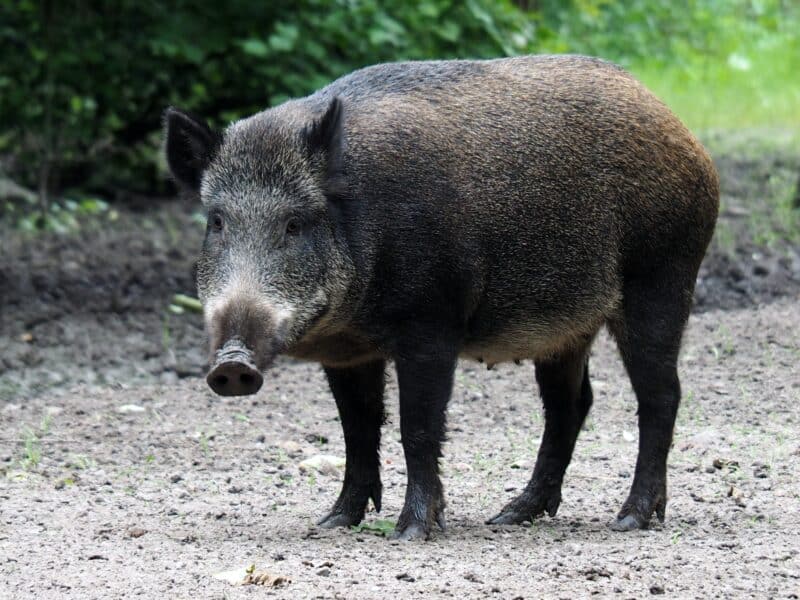
Wild boars, known for their destructive tusks, are among the largest warm-blooded animals on the planet. They live in the wild and are omnivores, with carbohydrates being a primary dietary need. While wild boars rarely attack humans, their aggression can be extremely dangerous, earning them a place on the list of the top 10 most aggressive animals.
There are however examples of these creatures being friendly, one of which being when a 2-pound wild boar grew up believing she is a puppy! You can read all about it with our dedicated article!
| Traits | Description |
|---|---|
| Tusks | Destructive tusks, among the largest |
| Diet | Omnivores, with a primary need for carbohydrates |
| Aggressiveness | Can be extremely dangerous, listed among the top 10 most aggressive animals |
Physical Characteristics and Behavior
Wild boars use their jaws and tusks in displays of aggression, often foaming at the mouth. They are covered with a double coat, which can vary in color from dark to red, brown, or dark. Their upper coat is coarse, while the undercoat is soft. Wild boars have long, rubbery noses that they use for digging up roots and tubers in the ground. They are medium-sized, well-evolved creatures and are omnivores that enjoy a varied diet, including berries, leaves, fruits, reptiles, worms, and snakes.
| Traits | Description |
|---|---|
| Coat Color | Varies from dark to red, brown, or dark |
| Nose Structure | Long, rubbery nose for rooting and digging |
| Diet | Omnivores, eat berries, leaves, reptiles, etc. |
Social Behavior and Lifespan
Male wild boars are typically solitary but may come together during the mating season. In the wild, their average lifespan is about ten years, but they can live up to 25 years in captivity.
| Traits | Description |
|---|---|
| Social Behavior | Male boars solitary, gather for mating |
| Lifespan | About ten years in the wild, up to 25 years in captivity |
#4 Hippopotamus
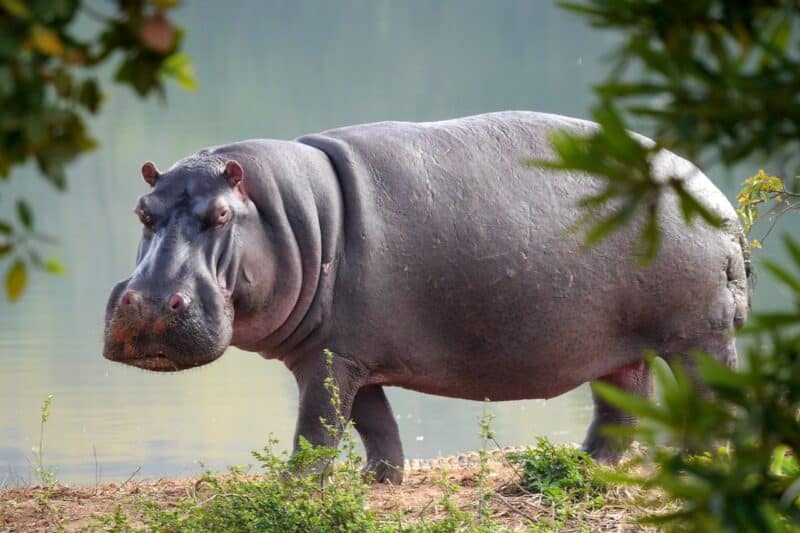
Hippos, semi-oceanic creatures, primarily feed on grass but are known for their unfriendly and sometimes dangerous behavior. They are considered mighty creatures, capable of attacking small boats and even causing fatalities. This is something you can read more about with our dedicated article on these powerful beasts! Despite their massive size, hippos are full of energy, even in conditions of limited water and food supply.
| Traits | Description |
|---|---|
| Diet | Mainly herbivores, grass, fallen fruits, etc. |
| Behavior | Can be aggressive, known for attacks |
| Size | Third-largest warm-blooded animal |
| Lifespan | About 5 years in the wild |
| Group Behavior | Found in groups of 10-30 individuals |
Physical Characteristics and Senses
Hippos are known for their massive size, which can be intimidating. Even baby hippos can weigh up to 100 pounds. They are considered one of the most dangerous creatures on the planet. Despite their large size, they have excellent sight, smell, and hearing.
| Traits | Description |
|---|---|
| Size | Massive, even baby hippos are sizable |
| Dangerous Nature | One of the most dangerous creatures |
| Sensory Abilities | Excellent sight, smell, and hearing |
Diet and Speed
Hippos are herbivores and consume a diet that includes grass, fallen fruits, sticks, and corn. Surprisingly, despite their size, they can outrun humans. Their lifespan in the wild is approximately 5 years.
| Traits | Description |
|---|---|
| Diet | Herbivores, grass, fruits, sticks |
| Speed | Surprisingly fast, can outrun humans |
Group Behavior and Water Dependency
Hippos are mainly found in groups of 10-30 individuals and invest a significant amount of energy in water, as they lack sweat glands. Whales and dolphins are considered their closest relatives.
| Traits | Description |
|---|---|
| Group Behavior | Found in groups of 10-30 organisms |
| Water Dependency | Need water for cooling, lack sweat glands |
| Close Relatives | Whales and dolphins are their relatives |
#5 Sun Bear
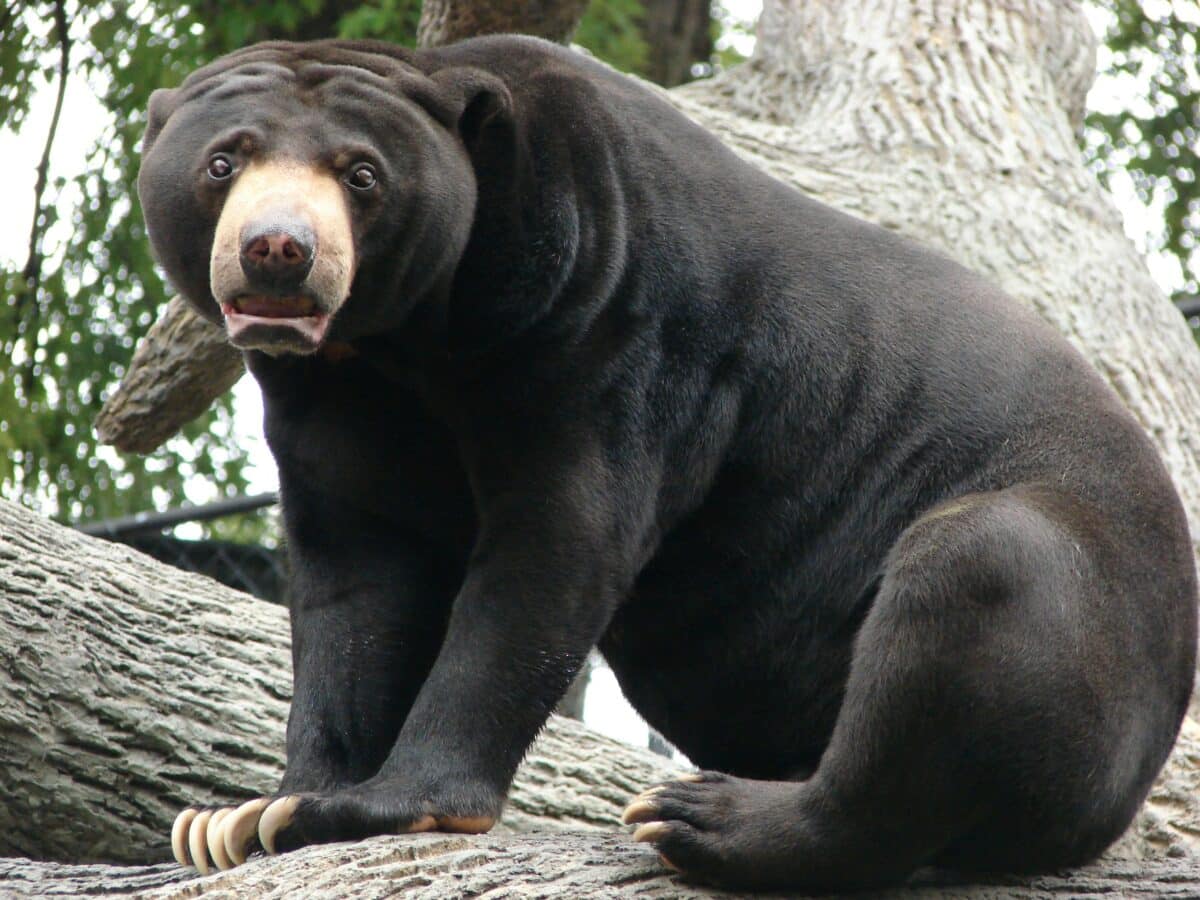
Sun bears, found in the rainforests of Southeast Asia, are the smallest of the bear family. These nocturnal creatures are mighty and known to attack for no apparent reason. They possess long, sharp teeth with enough power, and they live in trees. Sun bears are solitary animals but come together during mating. Their diet primarily consists of natural products, occasional small insects, and small rodents.
| Traits | Description |
|---|---|
| Size | Smallest among bear family |
| Behavior | Nocturnal, can be aggressive |
| Physical Features | Sharp teeth, tree-dwelling, small ears |
| Diet | Mainly natural products, insects, rodents |
Physical Characteristics and Behavior
Sun bears are miniature carnivorous bears covered with thick fur, which can range from brown to dark or dark brown. They have a U-shaped, distinctive patch of white, yellow, or orange fur on their chests that appears to extend up to their faces. They have sturdy, muscular bodies, small ears, and large fangs. Sun bears are often seen in trees, where they can be solitary or occasionally in pairs. They are known to vocalize, particularly when attacked.
| Traits | Description |
|---|---|
| Fur Color | Brown, dark, or dark brown with chest patch |
| Body Structure | Sturdy, muscular, large fangs |
| Tree-Dwelling | Mostly seen in trees |
| Vocalization | Can vocalize, especially when attacked |
Lifespan and Size
The species has an average lifespan of about 25 years in the wild and over 30 years in captivity. Sun bears are relatively small. Weighing just 27-65 kg (59-143 pounds) and growing to a length of 1-1.2 m (3.3-4 feet) with a 5cm (2-inch) tail. They have large forepaws with long, curved claws, which they use for tearing or digging to search for insect homes and colonies. Especially those of honey bees and termites.
| Traits | Description |
|---|---|
| Lifespan | About 25 years in the wild, over 30 years in captivity |
| Weight | 27-65 kg (59-143 pounds) |
| Length | 1-1.2 m (3.3-4 feet) |
| Claw Function | Long, curved claws for insect hunting |
Diet and Omnivorous Nature
Sun bears have an omnivorous diet, including fruits, honey, and small vertebrates. While bears, in general, are omnivorous, their dietary preferences can vary significantly. Ranging from seals for the predatory polar bear to various vegetation for the mostly herbivorous spectacled bear. The giant panda, however, exclusively consumes bamboo. Despite their size, most bears are agile and proficient swimmers.
#6 Saltwater Crocodile
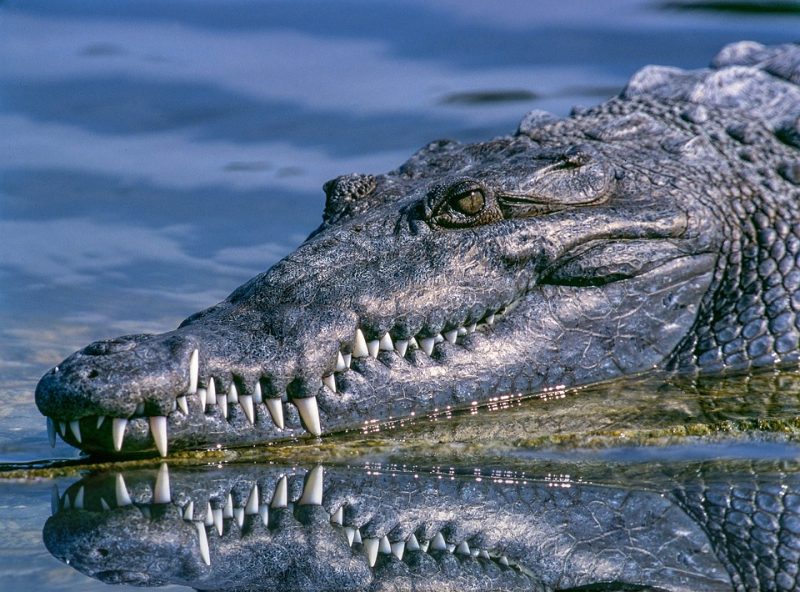
The king crocodile is the most enormous living crocodile in the world. Considered one of the dominant hunters on the planet and the strongest of all. They are not only powerful but also dangerous to humans, ranking among the top 10 most aggressive animals. There are even reports of saltwater crocodiles chasing boats and attacking people.
| Traits | Description |
|---|---|
| Size | Enormous, largest living crocodile |
| Strength | Dominant hunter, among the strongest |
| Danger to Humans | Known to be dangerous to humans |
| Aggressiveness | Ranks among the top 10 most aggressive animals |
Swimming Abilities and Lifespan
King crocodiles are excellent swimmers and can cover impressive distances, with the ability to swim up to 900 km. They have a relatively long lifespan of about 65 years.
| Traits | Description |
|---|---|
| Swimming Ability | Excellent swimmers, cover up to 900 km |
| Lifespan | Average lifespan of about 65 years |
Physical Characteristics and Habitat
They are among the mightiest creatures on the planet and the largest living reptiles. They can reach lengths of up to 5m, although there have been reports of specimens measuring up to 8m. They are native to regions from northeastern Australia to India and Southeast Asia.
| Traits | Description |
|---|---|
| Size Range | Can measure up to 5m, reports of up to 8m |
| Geographic Range | Native to regions from Australia to Southeast Asia |
| Preferred Prey | Fish, mammals, birds, active hunters at night |
#7 Cassowary
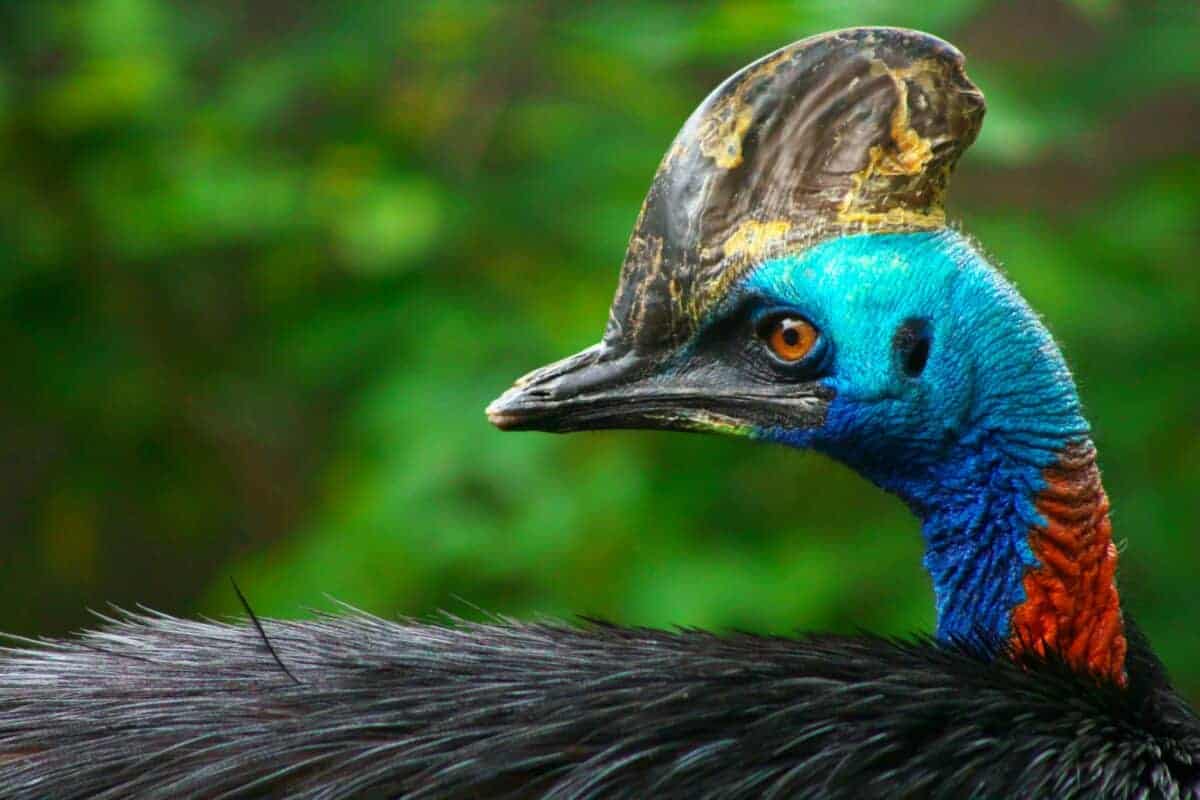
Cassowary is one of the giant living birds and holds the Guinness World Record for the most dangerous bird in the world. There are three surviving types of this bird, and can run at an acceleration speed of up to 50 km/h.
| Traits | Description |
|---|---|
| Types | Three surviving types |
| Speed | Capable of running at 50 km/h |
| Lethal Legs | Legs can tear prey into two pieces |
| Size | Third largest and second heaviest bird |
Physical Characteristics
Cassowaries are large-bodied birds with dark plumage, bluish skin, and pink necks. They have a ruddy neck with part of the legs being blue. However, the underside is dark. The neck and head color change depending on the bird’s state of mind.
| Traits | Description |
|---|---|
| Plumage | Dark with bluish skin and pink neck |
| Color Variations | Neck and head color change based on emotions |
| Size | One of the most dangerous birds on the planet |
Sensory Abilities
Cassowaries have excellent hearing and a remarkable sense of feeling, allowing them to distinguish low-intensity sounds from considerable distances. The bird has 1219 males and 0 and 50 male prisoners.
| Traits | Description |
|---|---|
| Hearing | Excellent hearing |
| Sense of Feeling | Distinguishes low-intensity sounds at a distance |
| Male Population | 1219 males, 0 and 50 male prisoners |
#8 Moose
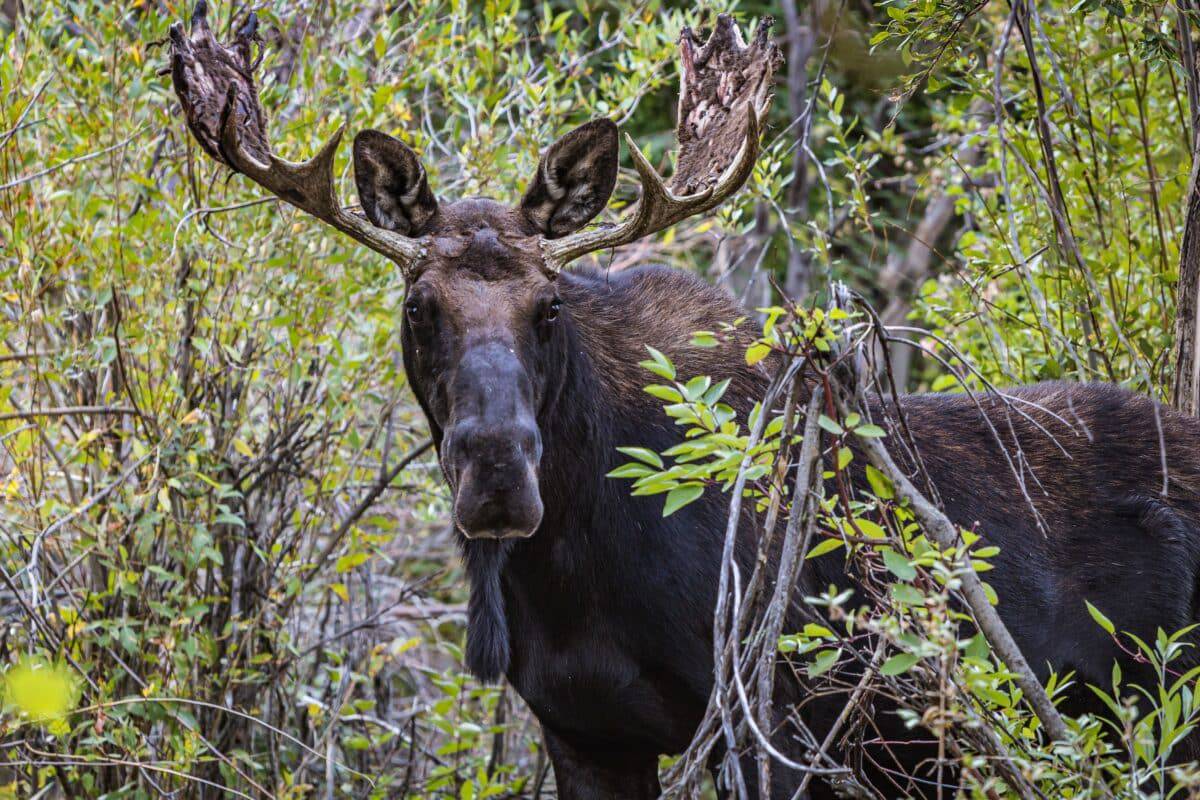
Known as one of the giant creatures found in the deer family. Moose are mainly found in the northern half of the globe and are prone to colder environments. They have migrated to summer near streams and creeks; fortunately, this species is not in danger. Males and females are about 6 feet tall at the withers but have different weights.
| Traits | Description |
|---|---|
| Habitat | Northern regions, cold environments |
| Migration | Summer migration near streams and creeks |
| Conservation Status | Not in danger |
| Size | About 6 feet tall at the withers |
Diet and Physical Characteristics
The critters are herbivores that eat plants and prefer aquatic plants, such as pond algae and water lilies. They are around 6 feet tall from the front to the back of the body, and they weigh around 450kg. Their hairs are brown, with variations in shade, which provide them protection. A fold is found under the throat of moose, a loose kind of skin generally found in various animals too.
| Traits | Description |
|---|---|
| Diet | Herbivores, preference for aquatic plants |
| Size | Approximately 6 feet tall and 450kg |
| Coat Color | Brown, with variations |
| Loose Skin Feature | Fold under the throat |
Antlers and Feeding Habits
Both males and females have antlers. The males’ antlers, however, are six feet long, while females have smaller antlers. They are herbivores. Mooses are very tall, making it difficult to bend their legs to eat grass on the ground. Therefore they prefer to eat tree leaves, twigs of trees, shrubs, and other plants in their approach. They also prefer to eat plants from ponds, rivers, lakes, small streams, etc.
| Traits | Description |
|---|---|
| Antlers | Both males and females have antlers; males have longer ones |
| Feeding Habits | Tall stature, prefer tree leaves, shrubs, aquatic plants |
#9 Wasps
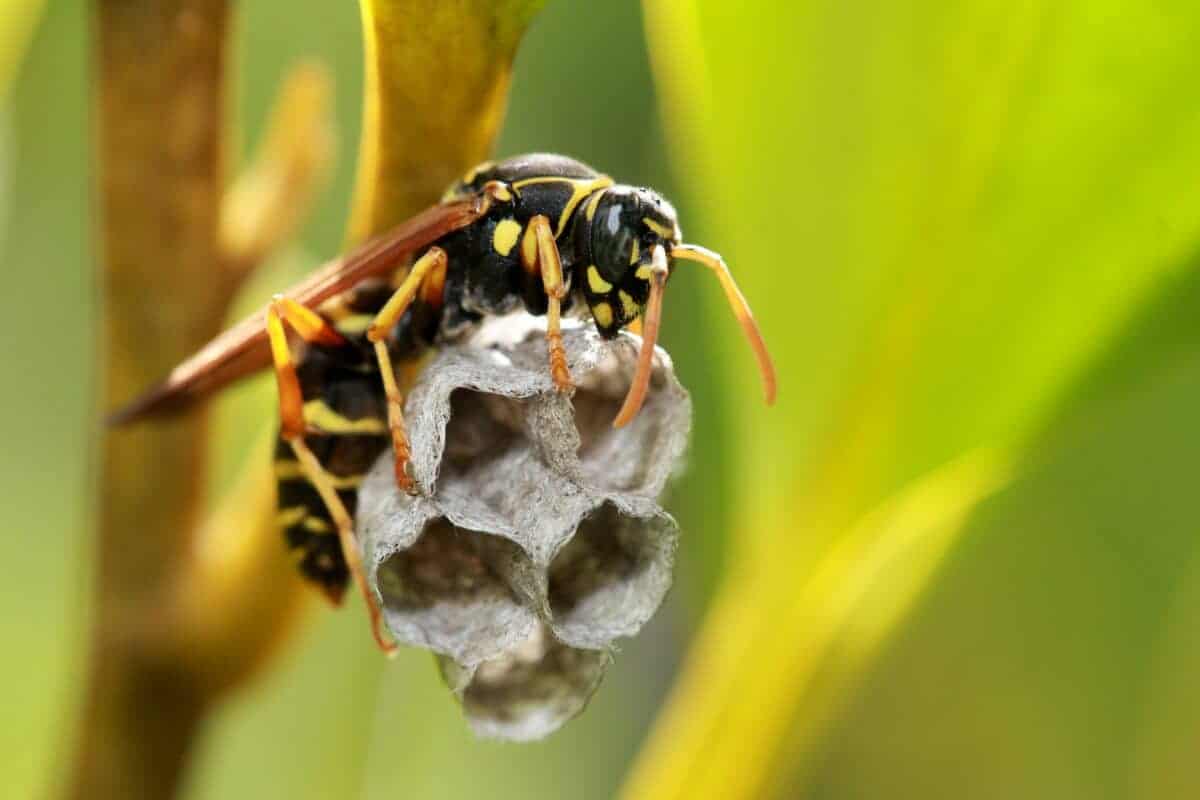
Most likely, the strongest creatures and insects are pretty quiet and charming. However, people despise them because they used to build houses near houses and can damage bushes and trees. The hunters are wild and hunt and eat insects that destroy crops. They also feed on aphids, grasshoppers, and various honey bees.
| Traits | Description |
|---|---|
| Behavior | Quiet and charming |
| Human Interaction | Often disliked due to nesting near homes |
| Diet | Predatory, targeting crop-damaging insects |
| Habitat | Found globally, excluding Antarctica |
| Nest Construction | Able to build nests out of paper and bark |
| Lifespan | Typically short, with some living for months |
Stinging Bugs and Health Implications:
Stinging bugs like honey bees, hornets, and wasps send over 500,000 individuals to the trauma center annually. Common home remedies for stings include covering the sting site with a meat tenderizer/water solution wash, a baking soda paste, or rubbing the site with an aluminum-based antiperspirant.
Varieties and Behavior of Wasps:
There are approximately 4,000 types of wasps in the United States. Wasps are generally active during the daytime and return to their nests at sunset. They are commonly seen during late summer and early autumn. This is when they search for food to sustain their colonies through the winter. Some wasps, like hornets, construct their nests hanging from trees, shrubs, vegetation, or even buildings. A mated queen establishes a new nest each spring. The workers then gradually expand it, sometimes to the size of a basketball by late summer. The queen is protected within the nest.
| Wasp Type | Description |
|---|---|
| Quantity in the US | Approximately 4,000 species |
| Activity | Mostly diurnal |
| Nesting Behavior | Hanging nests in various places |
| Nest Expansion | Workers gradually enlarge nests |
| Queen Protection | The queen is safeguarded |
Specifics about Bald-Faced Hornets:
Bald-faced hornets are aggressive and will defend their territory against any intruder. They possess smooth stingers, allowing them to sting repeatedly. Their stings contain venom that causes pain, itching, or swelling for approximately 24 hours. Similar to other hornet stings, people are at risk of allergic reactions from a bald-faced hornet sting.
| Characteristics | Description |
|---|---|
| Aggressiveness | Protect territory aggressively |
| Stingers | Smooth stingers for repeated stings |
| Venomous Stings | Cause pain, itching, and swelling |
| Allergic Reactions | Risk of allergies from their stings |
#10 Tasmanian Devil
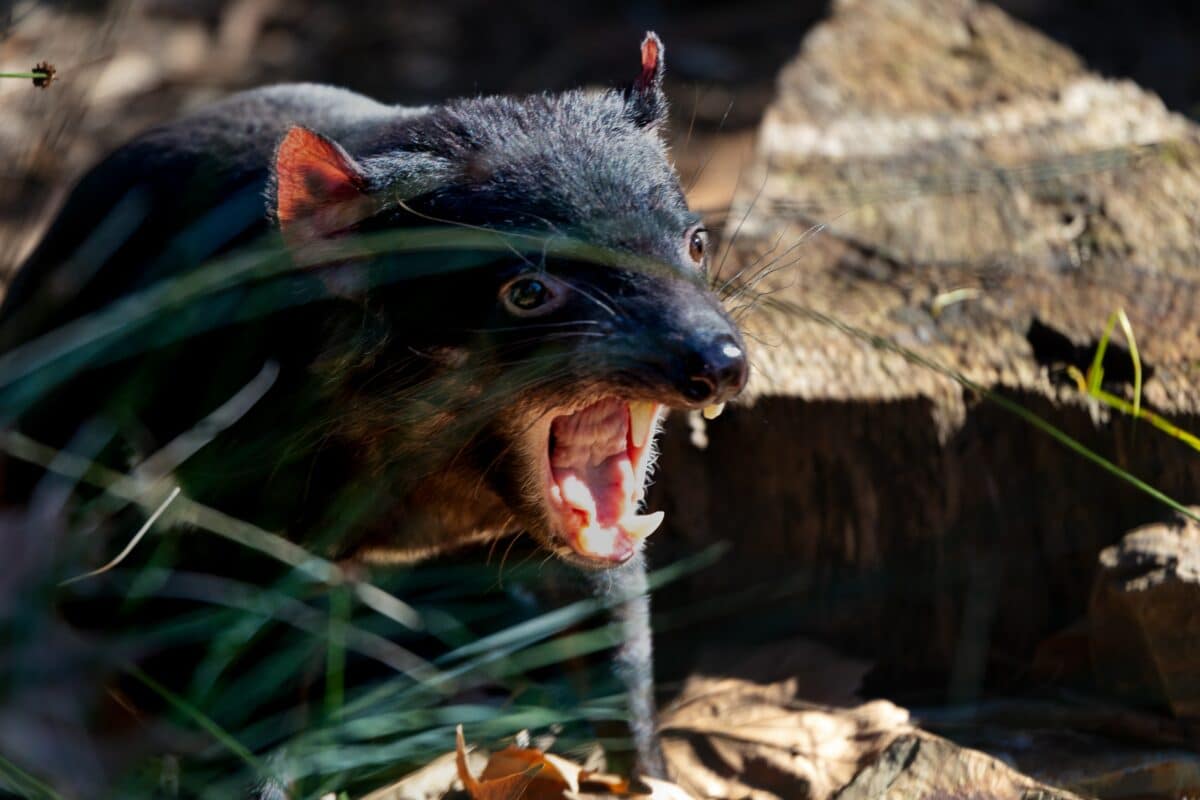
The Tasmanian Devil, the largest evergreen marsupial, ranks among the most powerful creatures on the planet. These creatures, resembling small dogs, have remarkable biting abilities and complex behaviors. Particularly during mating, where they engage in fierce battles to ensure their offspring’s survival.
| Traits | Description |
|---|---|
| Size | Similar in size to a small dog |
| Biting Ability | Possess one of the most basic gnawing abilities |
| Mating Behavior | Engage in complex and vital fights during mating |
| Appearance | Covered with dark fur, white patches on chest, back, and shoulders |
| Senses | Excellent visual and olfactory perception used for hunting |
Behavior and Reproduction
Tasmanian Devils are carnivorous creatures, often hunted by other predatory and deadly species. They have an average lifespan of about 7 to 8 years in the wild. When alone, they can engage in battles with other creatures for dominance. Typically using a high-pitched whistle as a challenge before a fight.
| Traits | Description |
|---|---|
| Diet | Carnivores, hunted by other predatory creatures |
| Lifespan | Average lifespan of 7-8 years in the wild |
| Dominance Behavior | Engage in battles with high-pitched whistles as challenges |
Summary of Top 10 Most Aggressive Animals
From big to small, it seems temper and aggression have no size!
If you enjoyed reading about the top 10 most aggressive animals. Check out top 10 longest living animals and top 10 deadliest animals in the world next!
Thank you for reading Top 10 Most Aggressive Animals.
- 10 Most Endangered Animals - April 15, 2024
- Top 10 Cutest Fish in the World - April 15, 2024
- 16 Top Predators in the Food Chain - April 12, 2024

